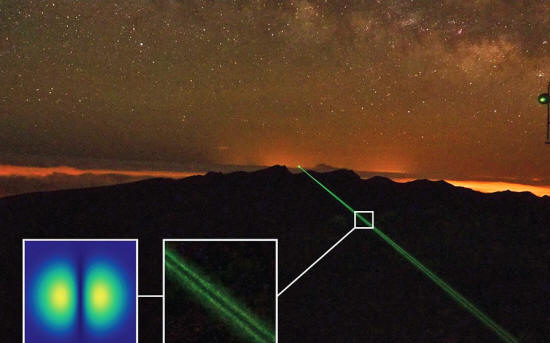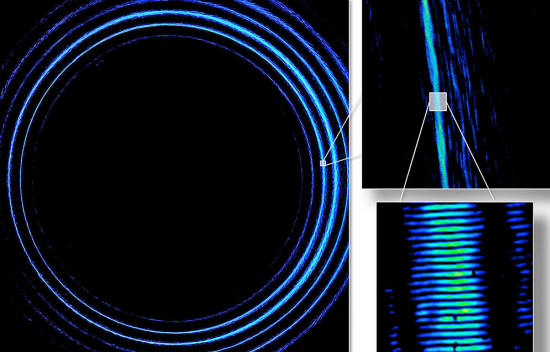|
by Jesse Emspak between two observatories on La Palma and Tenerife Islands. The receiver was able to detect how the light had been "twisted." Here, a twisted bit of light
as it travels
between the islands.
A recent experiment shows it may be possible to "twist" light waves, cram in more information than ever before, and send the signal over a practical distance.
In this case, the physicists used twisted laser light to send the message "Hello World" between two islands.
Twisted photons
Light waves are used in communications all the time.
Radio is a form of light, as are lasers that are common in fiber optics. To get information in and out, one can use the amplitude of the wave (as in AM radio), the wave's frequency (used in FM radio) and even the phase and polarization (used in fiber optics along with the first two).
The fact that one can use just four features, or so-called degrees of freedom, to encode information into a single light wave limits how much can be communicated via a photon.
An international team from the University of Vienna wanted to see if they could encode information into another feature, the angular momentum, of a light wave, and send it far enough to be useful - in this case, about 88 miles (142 kilometers) between two observatories in the Canary Islands.
This false-color image of a laser beam reveals that when zoomed in twice, the light wave has amazing complexity. Credit: Copyright: IQOQI Vienna / Robert Fickler
Counterintuitive as it sounds, light has angular momentum.
This is because as the photon propagates it actually "twists" and makes a certain number of revolutions. In recent years, physicists have found ways to increase the number of those twists, altering the light's angular momentum.
In this case, "n" is the number of "modes" in the light's angular momentum. Modes are integer multiples of angular momentum measurements.
A transmission with five modes, for example, and 10 channels, would now have the capability of sending five times as much information as the original 10 channels could.
Light travel
Ordinarily, if one looked at the laser light in the experiment hitting a blank screen, it would appear as a ring.
Using a computer to superimpose the angular momentum measurement on the light signal creates distinct patterns that can be decoded. The researchers used this method to create a light pattern that resulted in the message "Hello World."
Encoding information was only part of the experiment, though. The next step was sending the information some distance away.
Previously, most people in the photonics field didn't think a message could be transmitted well through the atmosphere, Mario Krenn said. That's because they assumed that angular momentum was sensitive to light's refractive index, something that changes with air pressure, or humidity.
They were wrong...
When the team fired a green laser beam between two observatories on the islands of La Palma and Tenerife, the receiver could still pick up the signal, detecting the changes in angular momentum the team had imparted to the twisted light.
Why it works is still a little unclear...
It could be that the assumptions about how much air interferes with these kind of measurements are simply incorrect.
With this success, the experiment opens the way for further work that could eventually be used in communications. Krenn said that the sender and receiver were relatively simple and off-the-shelf.
The computational heavy lifting was processing the signal, but that, too, used well-worn mathematical technique.
The results were published in two studies, ...in the Nov. 15 issue of the journal Proceedings of the National Academy of Sciences.
|



